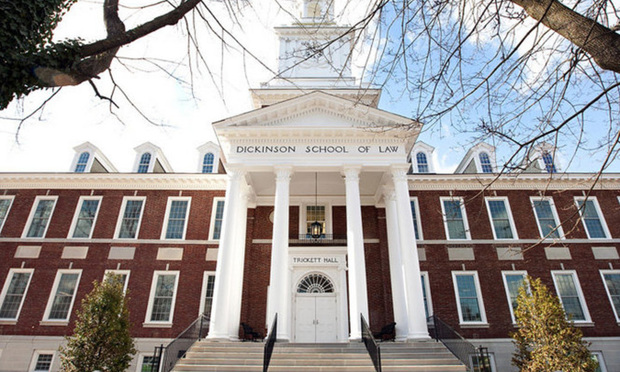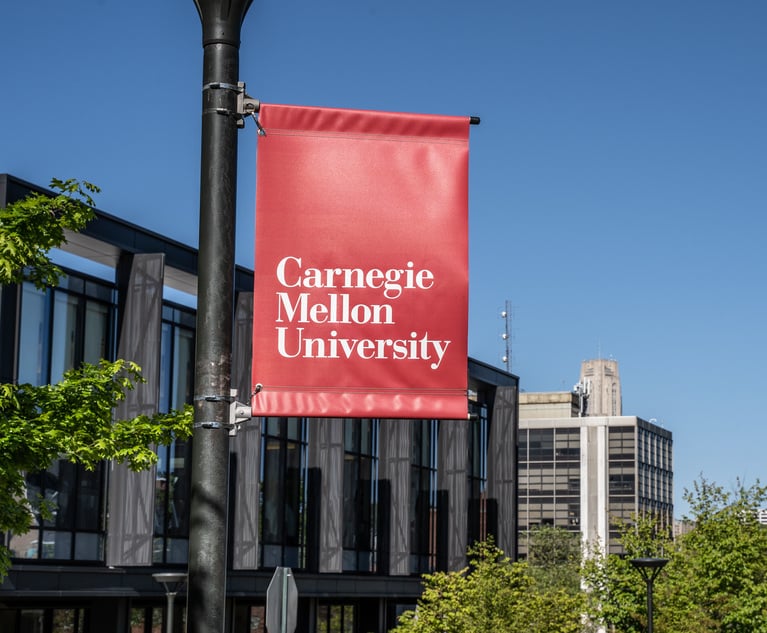Latest U.S. News Law School Rankings a Boon for Drexel, Bittersweet for Penn State
This year's list is unusually stable compared with previous years. The top schools remained entrenched while the lower portions of the rankings saw relatively few double-digit changes.
March 12, 2019 at 01:00 AM
7 minute read
The original version of this story was published on Law.com
 Penn State Dickinson School of Law.
Penn State Dickinson School of Law.
The latest edition of U.S. News & World Report's annual Best Law Schools list contained both good news and bad news for Pennsylvania State University, as its two law schools turned in markedly different performances in this year's rankings. Meanwhile, the Thomas R. Kline School of Law at Drexel University had cause to celebrate, making the top 100 for the first time this year.
Penn State Law, in University Park, rose 10 spots in the rankings to No. 64. Penn State Dickinson Law, in Carlisle, fell 12 spots to No. 71.
Nicholas Jones, Penn State's executive vice president and provost, said in an emailed statement, “We are proud of the progress being made at both of Penn State's law schools and their important contributions to legal scholarship, the education of future attorneys, and addressing societal challenges. Both schools have made gains in key metrics, including strong bar passage and employment—crucial to serving our students—and admissions standards. Their innovative experiential and interdisciplinary programs, drawing from each school's strengths, prepare our graduates to positively contribute in a rapidly changing legal marketplace. U.S. News measures only some of these important contributions.”
Kline Law School, meanwhile, tied for No. 100 with the Maurice A. Deane School of Law at Hofstra University, the Paul M. Hebert Law Center at Louisiana State University-Baton Rouge and the College of Law at West Virginia University.
“We're very pleased to be included among the U.S. News Top 100, but we also know that that ranking understates all the success we're seeing in the classroom and, particularly, in the workplace,” Daniel Filler, dean of Kline Law School, said in an email. “Employers tell us that we're preparing adept and gritty young lawyers. Our alumni accomplishments over 10 short years confirms it. These are our most meaningful metrics.”
Other Pennsylvania law schools that made the top 100 were Charles Widger School of Law at Villanova University, which dropped from No. 65 last year to No. 71 this year; Temple University's Beasley School of Law, which moved from No. 47 last year to No. 48 this year; and the University of Pittsburgh School of Law, which went from No. 74 last year to No. 78 this year.
This year's list, released Tuesday, offers relatively little drama among the 20 highest-ranked schools. The biggest change among that group was the University of Southern California Gould School of Law's jump from No. 19 last year to No. 17 this year. Beyond that, the University of Virginia School of Law; Duke University School of Law; Northwestern University Pritzker School of Law; and the University of California, Los Angeles School of Law each picked up one spot.
The University of Michigan Law School; the University of California, Berkeley School of Law; the University of Texas School of Law; and Vanderbilt University Law School each slipped one position.
But the top seven schools remained the same for the second straight year, with Yale Law School at No. 1, followed by Stanford Law School; Harvard Law School; the University of Chicago Law School; Columbia Law School; New York University School of Law, and the University of Pennsylvania Law School. The No. 10 spot is a three-way tie between Duke, Northwestern and Berkeley.
Movement among schools increased further down the list. The University of Florida Levin College of Law gained 10 spots to land at No. 31, while the University of North Carolina School of Law rose 11 spots to No. 34. Aside from Penn State Law, other schools that gained 10 or more spots on the ranking were Northeastern University School of Law; Brooklyn Law School; The University of Tulsa College of Law; Florida International University College of Law; the University of Hawaii William S. Richardson School of Law; the City University of New York School of Law; Drake University Law School; and the University of Toledo College of Law.
Howard University School of Law saw the biggest jump, climbing 20 spots to land at No. 108 this year. Dean Danielle Holley-Walker did not respond to requests for comment on the Washington, D.C., school's ascendance this year, but data from U.S. News shows that it scored higher in the peer assessment, meaning how other legal academics rated it, and posted a significant improvement in the percentage of graduates employed at graduation: from 35 percent last year to 61 percent this year.
The University of Maine School of Law posted the largest drop on this year's list, from No. 106 last year to No. 126 this year. The school's ranking is unusually volatile, a phenomenon Dean Danielle Conway has previously attributed to its small size and location in a small legal market, which makes it difficult for gradates to have jobs lined up at graduation. The school had the biggest increase on last year's ranking, with a 33-spot climb. But it was the biggest decliner the year before that, falling 28 spots.
The University of Cincinnati College of Law posted this year's second-largest decline, falling 18 spots to No. 83. Interim Dean Verna Williams said that the school is “surprised and disappointed” by that drop.
“Our ranking has fluctuated over the last five years—from 79 to 82, then up to 60 and down to 72, and from 65 to 83,” she said. “These shifts reflect the variety of challenges the market has faced during that period. They don't capture the innovative work the college accomplishes through Ohio Innocence Project, the highly successful Entrepreneurship and Community Development Clinic, our productive faculty, and the nation's first law student diversity case competition, for example. Our best days are ahead of us as the university selects our next leader, our new home approaches construction, and Cincinnati remains a vibrant city for young professionals.”
In addition to Penn State Dickinson Law, the University of Washington School of Law; Louisiana State University Paul M. Hebert Law Center; Indiana University Robert H. McKinney School of Law; Cleveland-Marshall College of Law; Washburn University School of Law; Mercer University Walter F. George School of Law; and the University of South Dakota each dropped 10 or more spots on this year's ranking.
Back on the list this year is Pepperdine University School of Law, which nearly cracked the top 50, coming in at No. 51. U.S. News left Pepperdine off the rankings last year after the school flagged a mistake in the figures it had reported to U.S. News pertaining to the median LSAT score of its newest class. (U.S. News provides each school an early copy of the list to check the accuracy of the data.) School administrators predicted that Pepperdine would have claimed the 62nd position had the correct LSAT number been factored in. The school's last official ranking was No. 72.
Pepperdine law Dean Paul Caron said he believes his widely read TaxProfBlog has helped spread the word about the law school and raise awareness of its strengths. That exposure, coupled with the stronger credentials and employment outcomes that the school has achieved due to smaller class sizes, has bolstered its ranking, he said.
“Our law school dinner is ordinarily held each year in early March,” Caron said. “But after last year's rankings hiccup, I decided to move this year's dinner to March 30 so it would take place after the release of the new law school rankings. I was so confident about the direction of our law school that we decided that the theme of this year's dinner would be that Pepperdine Law is 'on the rise.' I am glad I was right, or it would have been a very awkward dinner!”
This content has been archived. It is available through our partners, LexisNexis® and Bloomberg Law.
To view this content, please continue to their sites.
Not a Lexis Subscriber?
Subscribe Now
Not a Bloomberg Law Subscriber?
Subscribe Now
NOT FOR REPRINT
© 2025 ALM Global, LLC, All Rights Reserved. Request academic re-use from www.copyright.com. All other uses, submit a request to [email protected]. For more information visit Asset & Logo Licensing.
You Might Like
View All
Sanctioned Penn Law Professor Amy Wax Sues University, Alleging Discrimination
5 minute read
Pa. Superior Court: Sorority's Interview Notes Not Shielded From Discovery in Lawsuit Over Student's Death
3 minute read
LSAT Administrator Sues to Block AI Tutor From Using ‘Famous, Distinctive’ Test Prep Materials
3 minute read
Disjunctive 'Severe or Pervasive' Standard Applies to Discrimination Claims Against University, Judge Rules
5 minute readTrending Stories
- 1Paul Hastings, Recruiting From Davis Polk, Continues Finance Practice Build
- 2Chancery: Common Stock Worthless in 'Jacobson v. Akademos' and Transaction Was Entirely Fair
- 3'We Neither Like Nor Dislike the Fifth Circuit'
- 4Local Boutique Expands Significantly, Hiring Litigator Who Won $63M Verdict Against City of Miami Commissioner
- 5Senior Associates' Billing Rates See The Biggest Jump
Who Got The Work
J. Brugh Lower of Gibbons has entered an appearance for industrial equipment supplier Devco Corporation in a pending trademark infringement lawsuit. The suit, accusing the defendant of selling knock-off Graco products, was filed Dec. 18 in New Jersey District Court by Rivkin Radler on behalf of Graco Inc. and Graco Minnesota. The case, assigned to U.S. District Judge Zahid N. Quraishi, is 3:24-cv-11294, Graco Inc. et al v. Devco Corporation.
Who Got The Work
Rebecca Maller-Stein and Kent A. Yalowitz of Arnold & Porter Kaye Scholer have entered their appearances for Hanaco Venture Capital and its executives, Lior Prosor and David Frankel, in a pending securities lawsuit. The action, filed on Dec. 24 in New York Southern District Court by Zell, Aron & Co. on behalf of Goldeneye Advisors, accuses the defendants of negligently and fraudulently managing the plaintiff's $1 million investment. The case, assigned to U.S. District Judge Vernon S. Broderick, is 1:24-cv-09918, Goldeneye Advisors, LLC v. Hanaco Venture Capital, Ltd. et al.
Who Got The Work
Attorneys from A&O Shearman has stepped in as defense counsel for Toronto-Dominion Bank and other defendants in a pending securities class action. The suit, filed Dec. 11 in New York Southern District Court by Bleichmar Fonti & Auld, accuses the defendants of concealing the bank's 'pervasive' deficiencies in regards to its compliance with the Bank Secrecy Act and the quality of its anti-money laundering controls. The case, assigned to U.S. District Judge Arun Subramanian, is 1:24-cv-09445, Gonzalez v. The Toronto-Dominion Bank et al.
Who Got The Work
Crown Castle International, a Pennsylvania company providing shared communications infrastructure, has turned to Luke D. Wolf of Gordon Rees Scully Mansukhani to fend off a pending breach-of-contract lawsuit. The court action, filed Nov. 25 in Michigan Eastern District Court by Hooper Hathaway PC on behalf of The Town Residences LLC, accuses Crown Castle of failing to transfer approximately $30,000 in utility payments from T-Mobile in breach of a roof-top lease and assignment agreement. The case, assigned to U.S. District Judge Susan K. Declercq, is 2:24-cv-13131, The Town Residences LLC v. T-Mobile US, Inc. et al.
Who Got The Work
Wilfred P. Coronato and Daniel M. Schwartz of McCarter & English have stepped in as defense counsel to Electrolux Home Products Inc. in a pending product liability lawsuit. The court action, filed Nov. 26 in New York Eastern District Court by Poulos Lopiccolo PC and Nagel Rice LLP on behalf of David Stern, alleges that the defendant's refrigerators’ drawers and shelving repeatedly break and fall apart within months after purchase. The case, assigned to U.S. District Judge Joan M. Azrack, is 2:24-cv-08204, Stern v. Electrolux Home Products, Inc.
Featured Firms
Law Offices of Gary Martin Hays & Associates, P.C.
(470) 294-1674
Law Offices of Mark E. Salomone
(857) 444-6468
Smith & Hassler
(713) 739-1250





